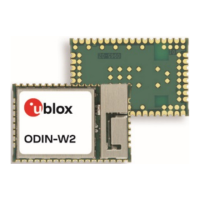ODIN-W2 series - System integration manual
UBX-14040040 - R20 System description Page 15 of 43
C1-Public
1.4.4 Restoring default configuration
In some situations, it is necessary to restore the settings to their default values. The following two
levels of restore to default configuration can be activated through hardware:
• Serial Settings: The serial settings are restored to default if SWITCH_1=’0’ during start-up. See
the table in Universal asynchronous serial interface (UART) section for more information about
the default serial settings.
• Factory Settings: The module will restore all factory settings if both SWITCH_1=’0’ and
SWITCH_0=’0’ for more than 10s during start-up. See the
u-blox Short range AT commands
manual [1]
for more information about the default factory settings.
1.5 Data communication interfaces
1.5.1 Universal asynchronous serial interface (UART)
The ODIN-W2 series module provides a Universal Asynchronous Serial Interface (UART) for data
communication. The ODIN-W2 series module can be in configuration mode (Command mode) and
data mode. See the
u-blox Short range AT commands manual [1]
for more information about the
different modes of the module.
The following UART signals are available:
• Data lines (RXD as input, TXD as output)
• Hardware flow control lines (CTS as input, RTS as output)
The UART can be used as both 4 wire UART with hardware flow control and as 2-wire UART with only
TXD and RXD. If using the UART in 2-wire mode CTS should be connected to GND on the ODIN-W2
module. The use of flow control is configured with an AT command. See the
u-blox Short range AT
commands manual [1]
for more information.
The Link status pins (DTR as output, DSR as input) are available as System IO signals, this is
described in System input and output signals section. It is recommended to use CMOS compatible
signal levels.
The UART interface is also used for software upgrade. See the
u-blox Short range AT commands
manual [1]
for more information about the software upgrade.
See the
ODIN-W2 series Data sheet [2]
for characteristic information about the UART interface.
Interface Default configuration
COM port 115200 baud, 8 data bits, no parity, 1 stop bit, hardware flow control
Table 5: Default settings for the COM port
1.5.2 Ethernet (RMII+SMI)
☞ The IO voltage of the ODIN-W2 is 1.8 V, which means that the RMII interface operates outside the
RMII specification v1.2. If the RMII has to be connected to a PHY circuit, then that circuit must
support 1.8 V operation. If a direct MAC to MAC connection is to be used, then a level shifter might
be needed depending on the selected host. The selected hardware setup must be verified on the
application board to guarantee operation.
RMII:
The ODIN-W2 series module includes a full RMII either for Ethernet MAC to MAC communication or
for MAC to PHY communication using the included Station Management Interface (SMI). The RMII
and SMI use 9 signals in total. The interface requires an external 50 MHz clock source either from a
compatible PHY chip or from an external oscillator. The ODIN-W2 series module cannot provide this
clock signal by itself.

